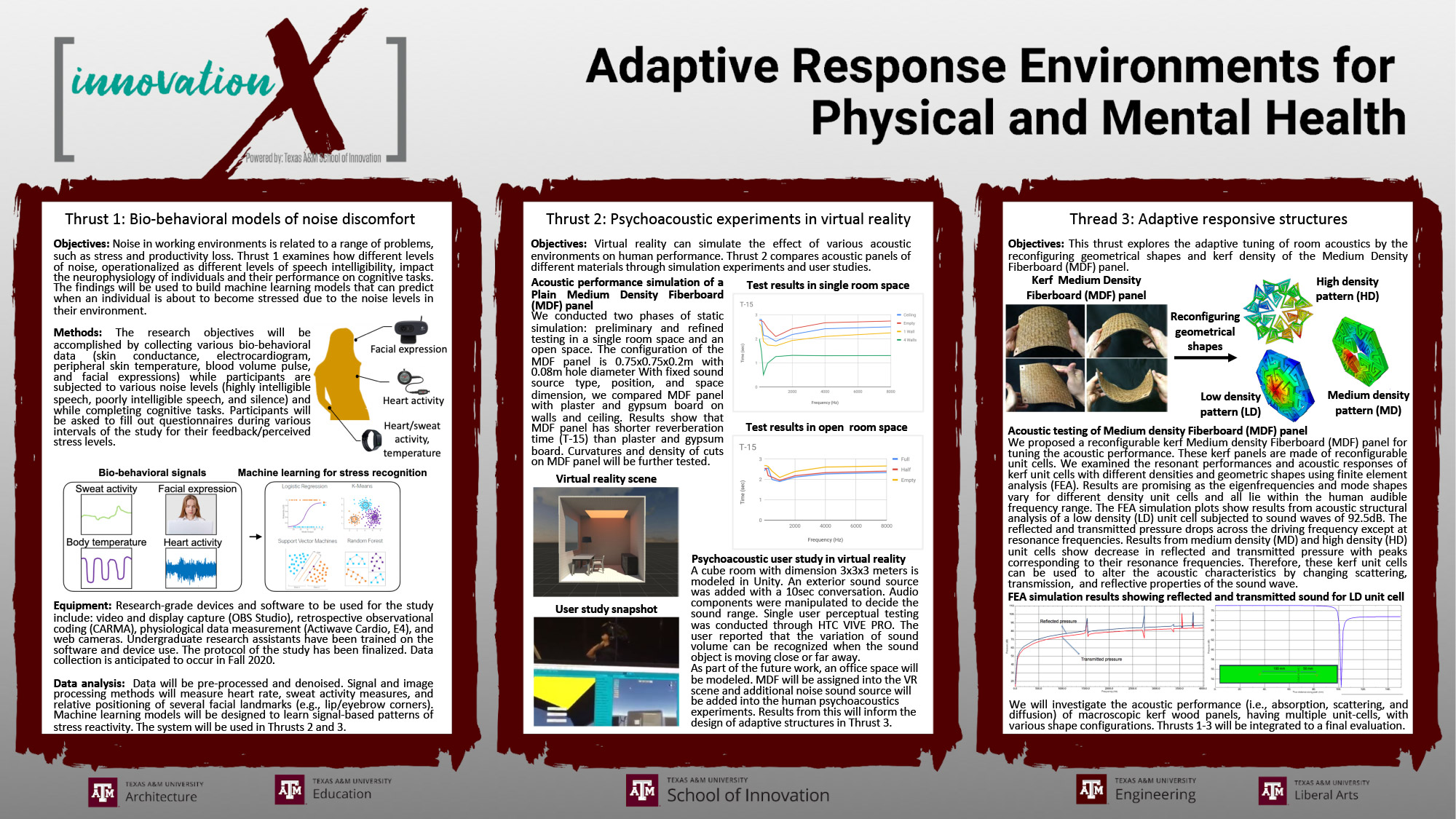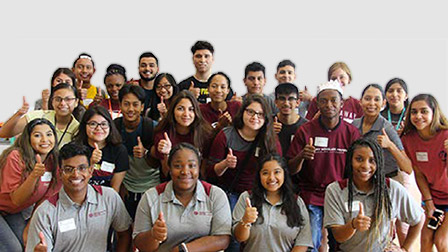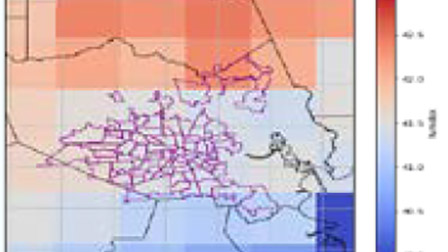Project Overview
Full Project Title
Adaptive Responsive Environments for Physical and Mental Health
Background
Light, colors, smells, and noises are several of the environmental factors that consciously or unconsciously affect our mood, cognition, performance, or even physical and emotional health. Prolonged thermal discomfort is associated with “sick-building” symptoms (e.g. dry throat), as well as serious health implications (e.g., hypothermia, loss of concentration, fatigue). Ambient light can moderate stress responses: warm-tone light is associated with increased alertness which might increase stress levels in comparison to cool-tone light. Exposure to prolonged noise can cause a range of health problems (e.g., stress, productivity loss, cardiovascular diseases). For individuals with neurological abnormalities, such as children with autism spectrum disorders (ASD), environmental discomfort yielding from noises, scents, light, and heat, can feel like a continuous bombardment. The inherent individual differences escalate these challenges. The environmental sensation is different for each person and a single condition cannot fit all individuals, therefore outlining the need of personalized solutions.
Projected Goals
The team proposes an intelligent and adaptive indoor living space which can continuously and unobtrusively “sense” each individual’s neuro-physiology, and then seamlessly and intuitively adjust the local environment (e.g., temperature, light) in a unique and personalized way to mitigate negative outcomes (e.g., increased stress). This effort relies on a cross-discipline between architecture, material science, construction science, psychology, and computer science, and consists of the three interconnected objectives.
Aim 1. Leveraging neuro-physiological indicators to identify individuals’ stress. A series of experiments will be undertaken to examine the relationship between neuro-physiological signals and human stress. Data collection will include 44 participants (18-30 years)–a sample size calculated by power analysis–, who will complete a series of cognitive tasks (e.g., proof-reading, online orders, email responses). A between-subjects design will be followed according to which each participant will be randomly assigned to one of the following conditions: (i) neutral, participants perform the assigned tasks at their own pace; (ii) time pressure, participants are given a reduced amount of time for the same tasks. In addition to retrospective self-reported stress levels, physiological responses (e.g., heart rate) and brain signals will be collected through commercially available wearable devices. Data analysis will identify significant neuro-physiological differences between the neutral and stress conditions.
Aim 2. Designing intelligent responsive and reconfigurable panels to achieve personalized environmental conditions. We will engineer responsive panels that can vary in size and can be effortlessly installed in stationary cubicles, furniture, or portable interior walls. Temperature and cool-light conditions will be manipulated through the panels, since these are the most relevant to mitigating stress. The panel’s basic elements are adaptive cells with multiple reconfigurable segments and imprinted apertures. Manipulation of the environmental conditions will be performed by the closing and opening of the apertures of the responsive panel, which will be connected to inlet and outlet of air circulating and cool-lighting systems.Aim 3. Assessing the ability of the adaptive-responsive environment to mitigate individuals’ stress response. The proposed responsive panels will be deployed with a new set of 44 participants, engaged in the same series of cognitive tasks as in Objective 1. The target degree of aperture opening will be based on the estimated/predicted level of stress (e.g., high stress will lead to increased aperture opening in order to reduce temperature and increase cool light conditions). Statistical analysis will identify whether the deployment of responsive architectures can significantly mitigate participants’ stress levels, as quantified by neuro-physiological and self-reported measures.
Projected Outcomes
The expected outcomes of the proposed work include: 1) research publications in high-impact conference and journals (e.g., IEEE Transactions on Affective Computing, International Journal of Non-Linear Mechanics); 2) a publicly available multimodal corpus to promote research on human-building interaction; 3) research findings regarding the interaction of humans with the surrounding environment, which will be used to pursue federal and industrial grant opportunities (e.g., NSF Smart & Connected Health, Department of Energy, Department of Education); 4) development of publicly available online repository of the proposed algorithms and structural design; 5) Master’s and undergraduate honor students’ theses. In the long-term, the findings from this work will be institutionalized creating novel modules in the PIs’ undergraduate and graduate classes (e.g., Machine Learning, Engineering Mechanics, Studio Design).
Meet The Team
Team Leaders
- Dr. Theodora Chaspari, Assistant Professor, Computer Science & Engineering; chaspari@tamu.edu; (979) 458-2205(979) 458-2205
- Dr. Anastasia Muliana, Professor, Mechanical Engineering
- Dr. James E. Hubbard Jr., Professor, Mechanical Engineering
Team Contributors
- Dr. Winfred Arthur, Professor, Psychology
- Dr. Youngjib Ham, Assistant Professor, Construction Science
- Dr. Jennifer Ganz, Professor, Educational Psychology
- Dr. Negar Kalantar, Assistant Professor, Architecture
- Dr. Dongying Li, Assistant Professor, Architecture
Graduate Student Team Members
- Sarra Bounouh, Computer Science, College of Engineering (Fall 2019)
- Ellen Hagen, Psychological & Brain Sciences, College of Liberal Arts
- Di Liu, Architecture, College of Architecture
- Zaryab Shahid, Mechanical Engineering, College of Engineering
Undergraduate Student Team Members
- Minji Choi, Computer Science, College of Engineering
- Summer Lehman, Psychological & Brain Sciences, College of Liberal Arts
- Yung-Hsin Tung, Architectural Engineering, College of Engineering
Units Represented
- Computer Science & Engineering
- Mechanical Engineering
- Psychology
- Construction Science
- Educational Psychology
- Architecture





